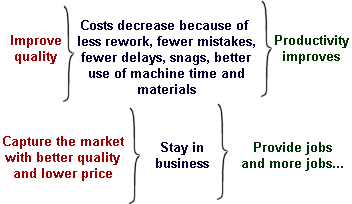The Pursuit of Excellence
A Manager's Guide to Quality
|
The Voice of the Process
|
Implications of Statistical Control
Shewhart proved that, by tracing and eliminating all the assignable causes of
variation from a process, it would be possible to bring it into a state of control.
If a process is in control, it is both stable and predictable (for
so long as it stays in control). This means that it is possible to predict with
reasonable certainty how well a process will perform in the future, based on results
obtained in the past. The shift in emphasis, from the output to the process means
that quality can be built into the product, rather than attempting to filter the
output through inspection. The economic benefits of this to both manufacturer and
customer are enormous.
- By removing the assignable causes of variation, it is possible to reduce the
overall process variation by a significant amount (the actual amount will vary
from process to process, but reductions of the order of 50% are not unheard of).
- A meaningful measure of the capability of the process can be
calculated. This means that it is possible to predict whether the process will be
able to meet the specification limits, as long as it stays in control. Capability
indices, which we shall look at later on, and which many customers want to know,
are meaningless if the process is not in a state of statistical control.
- It is possible to adjust the aim of the process, so that it is centred more
nearly on the target value. This adjustment can be made not by intuition or surmise,
but by the reliable use of past data.
- The effects of any changes made to the way the process is operated can be
measured with greater reliability.
- The predictability of the process means that the cost of scrap and rework are
greatly reduced or eliminated.
- The general quality of the final product goes up, which is good for the
customer.
- Rejected lots and late shipments go down which is good for everybody.
In Japan in the 1950s, Dr. Deming used the following model to emphasise the benefits
of quality improvement strategies.
|
